2. 中国地质大学(武汉) 资源学院, 地质过程与矿产资源国家重点实验室, 武汉 430074
2. Faculty of Earth Resources, China University of Geosciences, State Key Laboratory of Geological Processes and Mineral Resources, Wuhan 430074, China
铂族元素(PGE)既是研究基性-超基性岩及其相关矿床的重要示踪剂,同时本身也是重要的贵金属矿产资源(Garuti et al.,1997;Brandon et al.,1999;Puchtel and Humayun,2000;王敏芳等,2012;Wang et al .,2015a)。铂族元素的富集和成矿主要与镁铁-超镁铁质岩体有关,近年来发现早古生代黑色岩系具有巨大铂族资源潜力(Xu et al.,2013),但全球铂族元素资源主要来自于镁铁-超镁铁质层状侵入体或岩浆Cu-Ni硫化物矿床(Wilson and Prendergast,2001;Lightfoot and Keays,2005;Hutchinson and McDonald,2008;Godel and Barnes,2008)。在铜镍硫化物矿床中,PGE与贱金属硫化物(磁黄铁矿、镍黄铁矿和黄铜矿)关系密切(Ballhaus and Sylvester,2000;管涛等,2004;Prichard et al.,2004;Chen et al.,2015),呈类质同象或者次显微包体等形式赋存于这些硫化物中,也可以形成Sb、Te、Bi、As化物和金属互化物等独立铂族矿物(简称PGM),且以后者为主(Coghill and Wilson,1993;Li and Naldrett,1993;朱文凤和梁有彬,2000;赵兴国等,2010;王建中等,2011),“PGM”常见赋存位置有3种:金属硫化物与硅酸盐矿物/蚀变矿物之间、硫化物内和硅酸矿物/蚀变矿物内等(王志辉等,1986;Coghill and Wilson,1993;Li and Naldrett,1993;赵兴国等,2010;王建中等,2011;Piña et al.,2012),PGM形成时间大多晚于硅酸盐矿物和金属硫化物(Li and Naldrett,1993)。铜镍硫化物矿床中PGE的富集机制主要有岩浆作用和热液作用2种模式,前者包括硫化物熔体富集PGE(Naldrett et al.,1990;Li et al.,2001a)、PGE“原子簇”富集(Tredoux et al.,1995)和PGM直接结晶沉淀(Hiemstra,1985)等,后者主要是含氯的热液流体运移PGE,遇地球化学障或者氧化还原障而结晶沉淀PGM,导致PGE在合适位置富集成矿(Coghill and Wilson,1993; Szentpeterik et al.,2002),并且这种流体包括矿物堆晶间热液流体(>500℃)和岩浆期后热液流体(200~300℃)(Hanley,2005)。
香山铜镍硫化物矿床发现于上世纪80年代,是东天山造山带内典型铜镍硫化物矿床,同时在杂岩体内还发现了钛铁矿-铜镍矿复合型矿体,引起了众多矿床学家的关注(王润民等,1987;孙赫等,2008;Qin et al.,2011;Su et al.,2012)。研究表明,香山铜镍矿床赋矿岩石和矿石样品中均富集PGE,总量最多可达到149×10-9(肖凡等,2013)。然而,前人对此矿床中PGE的研究,仅限于用作地球化学指示剂示踪成岩成矿过程(孙赫等,2008;肖凡等,2013),PGE究竟是通过哪种地质作用得到富集?目前尚未见报道。本文对矿石中主要金属硫化物开展电子探针分析,试图解决上述问题。
1 成矿地质背景东天山地处古亚洲洋南缘,是西伯利亚板块和塔里木板块的聚合地区,前人认为区内俯冲碰撞作用在中晚石炭世已经结束,并于二叠纪开始进入板内构造阶段(Zhou et al.,2004;Mao et al.,2008)。从现在的构造构架来看,它主要由觉罗塔格构造带和中天山地块组成(图 1),其中觉罗塔格构造带的地层主要为泥盆-石炭纪海相火山碎屑岩,均遭受了挤压推覆(活动时间280.2~300 Ma)和右行走滑(活动时间242.8~262.9 Ma)两期剪切作用,最终形成康古尔韧性剪切带(陈文等,2005)。中天山地块具有前寒武纪的结晶基底和下古生界盖层,其北缘也发育一条中二叠世韧性剪切带(陈毓川等,2008)。区内断裂构造发育,其走向以东西向为主,次为北北东向,从北至南规模较大者依次有:①骆驼圈子断裂、②头苏泉断裂、③康古尔断裂、④苦水断裂、⑤沙泉子断裂、⑥中天山地块南缘断裂。岩浆岩以海西期最为发育,种类多样,既有铜镍、钒钛矿化关系密切的镁铁质-超镁铁质岩,又有与其他矿化有关的闪长玢岩、花岗闪长斑岩和花岗岩。
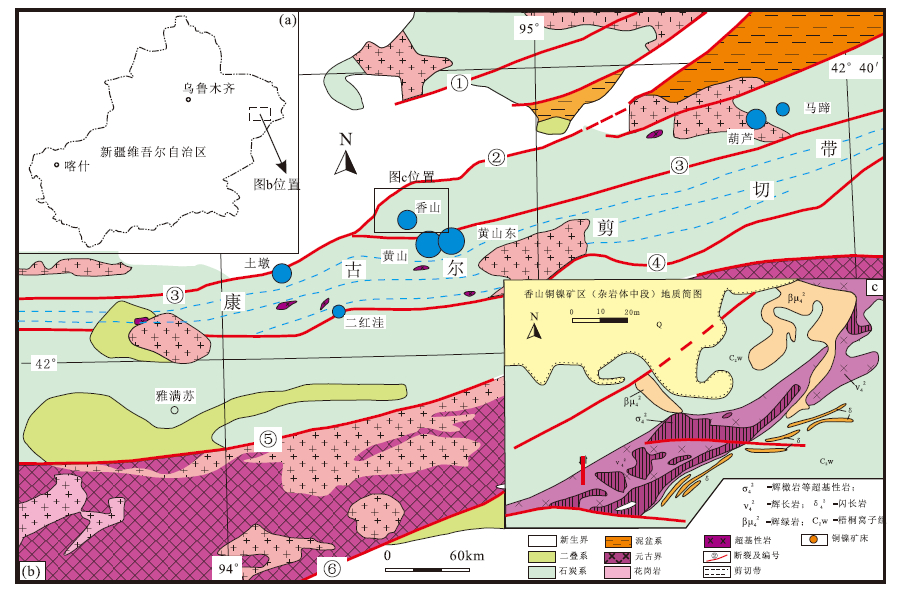
|
图 1 东天山铜镍矿带(a,b)及香山铜镍矿区地质简图(c)(据竺国强等,1996;王京彬等,2006) Fig. 1 Simple geological maps of the Xiangshan Cu-Ni deposit(c) and the Cu-Ni mineral belt in the Eastern Tianshan(a, b)(after Zhu Guoqiang et al., 1996;Wang Jingbin et al., 2006) |
在觉罗塔格构造带内,镁铁质-超镁铁质岩体呈近东西向带状分布,依次有土墩-二红洼、香山—黄山—黄山东和葫芦—串珠—马蹄-图拉尔根—四顶黑山等,现已探明黄山、黄山东和图拉尔根3处大型铜镍矿床,香山中等多处中型铜镍矿床以及香山西大型铜镍-钛铁矿床。中天山地块北缘也出露含铜镍矿和钒钛磁铁矿的镁铁质-超镁铁质岩体,包括尾亚、天宇和白石泉等。关于上述岩浆型矿床的成矿动力学背景研究较多,目前主要有地幔柱(Zhou et al.,2004;Pirajno et al.,2008;Qin et al.,2011; Su et al.,2012)和后碰撞(汤中立和李文渊,1996; 汤中立等,2004;王京彬等,2006;Mao et al.,2008; Wang et al .,2015b)等认识。
香山铜镍硫化物矿床位于东天山康古尔韧性剪切带北缘,黄山铜镍矿田北部(图 1),研究区内地层出露简单,为一套火山碎屑岩和正常沉积岩建造,也有人认为存在中元古代地层(夏明哲,2009)。区内构造-岩浆事件复杂,申茂德(2003)认为该区域内整体为轴向近东西的复式倒转背斜。矿区内岩浆岩从酸性岩到超基性岩均有出露,王润民等(1987)在含铜镍矿杂岩体外围火山岩区辉长岩-闪长玢岩之间过渡带内发现有富铜-特富铜矿体,但勘查资料不详。目前有关香山中段杂岩体岩相学和岩石地球化学特征已有很多报道,本文不再赘述。
在香山中段杂岩体内,共圈定出8个铜镍矿体,依其规模和工业利用前景,8个矿体中有主矿体1个(Ⅱ)、主要矿体1个(Ⅰ)和次要矿体3个(Ⅲ、Ⅳ、Ⅰ-36.9-2、16-Ⅰ),其他均为小矿体。Ⅱ号主矿体分布于辉长岩和橄榄岩之间(图 2),具向南倾斜变厚的趋势。矿石类型有浸染状、致密块状和脉状3种类型,其中浸染状矿石和致密块状矿石为岩浆熔离成因,脉状矿石为热液成因。矿石中的金属矿物以硫化物为主,其次是氧化物和硫砷化物、砷化物、碲化物等。金属硫化物有磁黄铁矿、镍黄铁矿、黄铜矿、针镍矿、紫硫镍矿、黄铁矿、白铁矿、方黄铜矿、辉铁镍矿、闪锌矿和方铅矿等;氧化物主要有磁铁矿、钛铁矿和铬尖晶石等。
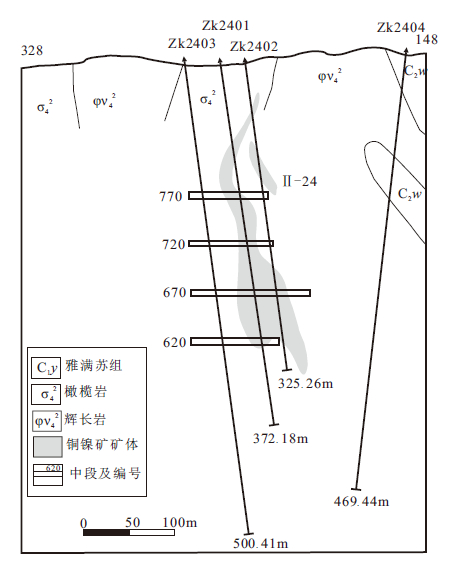
|
图 2 香山铜镍矿床24#勘探线剖面图 (据新疆有色704队,2008改编) Fig. 2 Profile of the 24# exploration line in the Xiangshan Cu-Ni deposit(modified after 704 Geological Brigade of Xinjiang, 2008) |
本次采集的样品来自于香山中铜镍矿区主采竖井位置(Ⅱ号矿体),包括稀疏浸染状矿石、富镍矿石和富铜矿石,其金属矿物组成如 图 3所示。在样品微量元素全岩分析基础上(肖凡等,2013),选取了PGE含量较高的矿石,对其中不同结构特征的金属硫化物(磁黄铁矿、镍黄铁矿和黄铜矿)开展了电子探针分析。测试单位为中国地质大学(武汉)地质过程与矿产资源国家重点实验室电子探针实验室,首先对矿石中金属硫化物富集的部位切制探针片(光薄片),然后进行喷炭处理,最后放入仪器测定,仪器型号为日本JXA-8100,工作加速电压20 kV,电流20 nA,分析束直径为5 μm,寻峰时间为10 s。本次所测元素的检测限分别为:Ni 51×10-6,Cu 73×10-6,Ti 50×10-6,Co 59×10-6,Fe 67×10-6,Zn 91×10-6,Au 143×10-6,Ag 49×10-6,Pt 249×10-6,Pd 103×10-6,Bi 116×10-6,Se 82×10-6,Sb 81×10-6,As 162×10-6,S 44×10-6,Te 114×10-6。
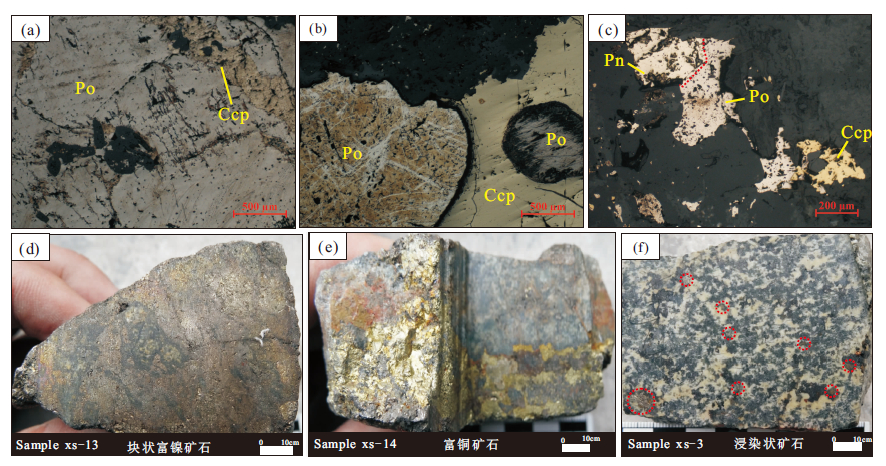
|
(a)、(b)、(c)分别为样品XS-13、XS-14和XS-3的光片照片,表现出磁黄铁矿(Po)、镍黄铁矿(Pn)和黄铜矿(Ccp)紧密共生特征,但黄铜矿 (Ccp)包裹磁黄铁矿(Po)和围岩角砾;(d)、(e)反映富镍矿石和富铜矿石中包裹围岩角砾或与围岩截然过渡的特征;(f)为浸染状矿石 图 3 香山铜镍矿床典型矿石特征 Fig. 3 Characteristics of typical ores in the Xiangshan Cu-Ni deposit |
分析发现矿石中主要金属硫化物的Pd元素含量普遍较低,大部分低于检测限,仅少数磁黄铁矿和镍黄铁矿矿物中含有少量Pd元素,因此本文仅研究Pt元素的富集机制。在主要金属矿物微量元素含量折线图中(图 4),发现主量元素差异大,如镍黄铁矿、磁黄铁矿Ni、 Fe、Co含量高,黄铜矿Cu含量高。微量元素也存在含量差异,如Sb、Bi和Zn等具低温习性的元素在黄铜矿中明显偏高。

|
Pn为镍黄铁矿,Po为磁黄铁矿,Ccp为黄铜矿; 微量元素含量低于检测限的未在图中表示 图 4 香山铜镍矿床铜镍矿石中微量元素折线图 Fig. 4 Plots of trace elements of Cu-Ni-bearing rocks in the Xiangshan Cu-Ni deposit |
测试数据(表 1)表明,相同金属矿物的Pt元素含量基本相同,以磁黄铁矿和镍黄铁矿最为明显,分别稳定在0.19%(范围0.14%~0.24%,均值0.19%)和0.18%(范围0.16%~0.22%,均值0.18%),二者十分接近。黄铜矿Pt元素含量变化较大,样品XS-14中黄铜矿含量高达0.14%,而样品XS-13和XS-3中Pt元素含量仅在0.06%~0.09%,不足0.1%。不同金属矿物之间,发现磁黄铁矿和镍黄铁矿中Pt元素含量相差不大,均高于黄铜矿中Pt元素含量,即使样品XS-14中黄铜矿含量略微增加,但仍未超过磁黄铁矿和镍黄铁矿。综上,可以认为香山铜镍矿床中不同金属矿物的Pt元素富集能力不一样,相比之下,磁黄铁矿和镍黄铁矿中Pt元素丰度更高,富集能力更强。
| 表 1 香山铜镍矿床中金属硫化物电子探针分析数据 Table 1 EPMA data of various sulfides in the Xiangshan Cu-Ni deposit |
Co和Se元素倾向富集于含磁黄铁矿和镍黄铁矿较多的矿石中,而Zn、Ag(Au)、Pt和Pd则倾向富集于含黄铜矿较多的矿石中(肖凡等,2013)。由于Co与Ni元素之间有很强的亲和性,Se与S也是如此,在本次金属硫化物电子探针分析中,发现磁黄铁矿和镍黄铁矿较黄铜矿中含有更多Ni和S(表 1),故不难理解Co和Se在含磁黄铁矿和镍黄铁矿矿物较多的矿石样品(XS13)中会有所富集。
本次分析表明,从磁黄铁矿、镍黄铁矿到黄铜矿,Sb、Bi和Zn含量逐渐增加(图 5),相对于Ni元素来说,元素Sb、Bi、Zn具有较强的低温习性,故黄铜矿较晚形成。研究表明,黄铜矿是在硫化物熔体发生单硫化物固溶体(Mss)分离之后,残余液相硫化物结晶所成,较之磁黄铁矿和镍黄铁矿,具有明显后生的特征(王建中等,2011)。从晶体化学角度来看,Ni、Fe、Cu元素的电价相同,但Cu的离子半径最大,一般在较晚阶段与S元素结合成黄铜矿。在本次研究中,发现富黄铜矿硫化物集合体呈脉状贯穿磁黄铁矿矿物或者包裹磁黄铁矿矿物/岩石角砾(图 3),也说明黄铜矿较晚形成。
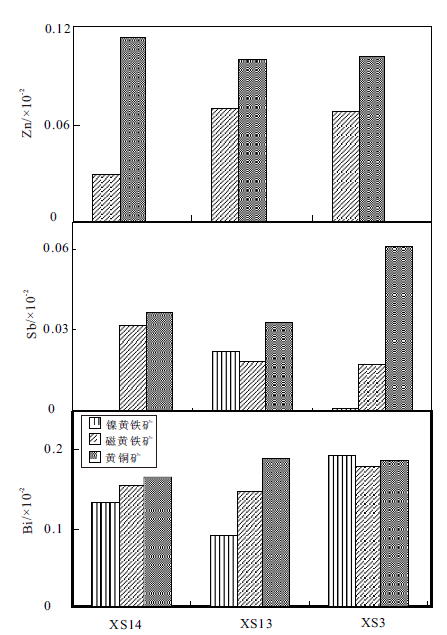
|
图 5 金属硫化物间Sb、Bi,Zn含量变化图 Fig. 5 Varieties of Sb, Bi, Zn in pentlandite,pyrrhotine, and chalcopyrite |
在铜镍矿床中,已有研究表明,PGE在岩浆体系硫不饱和阶段(或氧逸度较高环境)会形成合金,以核形式被包裹于铬铁矿和橄榄石等早期晶体相中,当岩浆体系达到硫饱和之后,会形成不混溶于硅酸盐熔体的硫化物熔体,“捕获”大量铂族元素后脱离硅酸盐熔体。熔离的硫化物熔体随后发生分异结晶,同时伴随平衡结晶,形成单硫化物固溶体相和残留液相(Ebel and Naldrett,1997;Naldrett,2004)2种不同相态,且Pt、Pd、As、Te、Bi等元素优先进入残留液相中,表现出“不相容性”特征。由于硫化物熔体核部和边缘冷却速率不一,导致边部分异强,核部分异弱,Cu、Pt、Pd、As等元素仅少量富集于残余液相中,而大多数被保留于单硫化物固溶体相中,最后形成了包含较多PGM的磁黄铁矿和镍黄铁矿(Li et al.,2001b)。
正如前文所述,香山铜镍矿床中磁黄铁矿和镍黄铁矿形成时间早于黄铜矿,铂元素倾向于在早期矿物中富集,而在晚期黄铜矿中相对较少,说明成矿岩浆演化过程中,也发生了硫化物熔体不均衡分异作用,从而导致Pt元素的选择性富集,即不同阶段形成的金属矿物中Pt元素含量不一样。
4.3 Pt元素富集机制关于岩浆硫化物矿床中PGE矿化成因问题,主要有岩浆作用和岩浆作用主导后期热液参与等模式(Hiemstra,1985;Naldrett et al.,1990;Tredoux et al.,1995;Li et al.,2001a),可统一称为“正岩浆”模型。众所周知,加拿大Sudbury、津巴布韦Great Dyke、以及中国金川、喀拉通克和黄山东等铜镍硫化物矿床中,均存在岩浆作用主导的铂族元素富集,并且形成可见形式的铂族矿物(朱文凤和梁有彬,2000;Li et al.,2001a;王建中等,2011)。近些年来,发现热液成因模式也能解释PGE矿化问题(Barnes and Maier,2002;Godel et al.,2007),主要受富氯热液流体影响(Boudreau and Meurer,1999;Willmore et al.,2002),如内蒙古文圪乞PGM形成于磁铁矿、绿泥石和黄铁矿中(赵兴国等,2010),Sudbury地区100,120和Lady Violet 矿床中PGM形成于含镍的辉砷钴矿中(Szentpeterik et al.,2002)。也有一些岩浆硫化物矿床中,PGE的矿化富集过程并不是单一的,而是岩浆成矿和热液流体成矿多阶段富集而成,如津巴布韦Sclukwe Subchamber矿床中(Coghill and Wilson,1993)。
在香山铜镍矿床内,矿石比岩石更加富集PGE,这与PGE具有强烈的亲硫性质紧密相关(肖凡等,2013),但矿石是岩浆成因还是热液成因尚不明确,故不能判断PGE的富集机制。在本次研究的样品中,通过磁黄铁矿的Ni-Co判别图解(图 6),发现香山铜镍矿床中磁黄铁矿与典型铜镍矿床中磁黄铁矿特征一致(Co/Ni<1),说明磁黄铁矿为岩浆成因,故岩浆作用是Pt元素的富集机制之一。
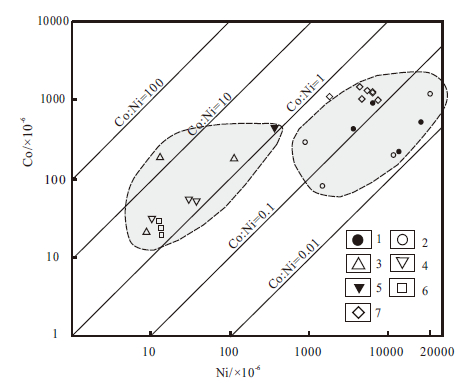
|
图 6 香山铜镍矿床磁黄铁矿Co-Ni关系 (底图据陈殿芬,1995) Fig. 6 Plot of Ni versus Co of pyrrhotite in the Xiangshan Cu-Ni deposit(modified after Chen Dianfen,1995) |
香山铜镍矿床中磁黄铁矿和镍黄铁矿的Pt元素含量高于黄铜矿,但富铜矿石(样品XS14)却含有更多Pt元素(矿石全岩分析数据表明,XS14为74.5×10-9,XS13为24.1×10-9,XS3为7.91×10-9)(肖凡等,2013),与黄铜矿中Pt元素含量低相矛盾。通过手标本观察和光/薄片鉴定,发现富铜矿石(样品XS14)内黄铜矿矿物集合体边缘存在许多热液蚀变矿物(图 7),表明存在后期热液作用改造,由于Pt元素热液活动性强,容易在热液作用条件下更富集Pt,并可能以某种类型PGM赋存于热液蚀变矿物中。因此,热液作用也是香山铜镍矿床中Pt元素的富集机制之一,今后可以在热液作用强烈地区寻找Pt元素矿化体。
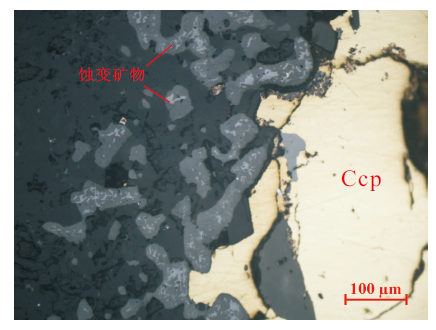
|
图 7 香山铜镍矿床富铜矿石中的蚀变矿物 Fig. 7 Altered minerals in Cu-rich ore in the Xiangshan deposit |
(1)磁黄铁矿和镍黄铁矿要比黄铜矿更加富集Co、Se和S元素,而黄铜矿更加富集元素Sb、Bi、Zn(Ag、Au)等具低温习性的元素,这与黄铜矿较晚生成有关;
(2)在矿物富集Pt元素能力上,磁黄铁矿、镍黄铁矿比黄铜矿更强,这种现象可以用硫化物熔体分异不均衡理论给予解释;
(3)香山铜镍矿床中富铜矿石之所以富集Pt元素,与岩浆成因磁黄铁矿、镍黄铁矿和黄铜矿矿物无关,而是与后期热液作用有关,因此矿区内热液作用较强地带具有寻找Pt元素矿化体的潜力。
致谢: 野外考察中得到中国地质大学(武汉)张雄华教授和廖群安教授给予的指导;样品制备和电子探针分析得益于中国地质大学(武汉)郑曙老师和陆建培老师的帮助,在此一并致以诚挚的谢意。
| Ballhaus C, Sylvester P. 2000. Noble metal enrichment processes in the Merensky Reef, Bushveld Complex. Journal of Petrology, 41(4): 545-561 |
| Barnes S J, Maier W D. 2002. Platinum-group element distributions in the Rustenburg Layered suite of the Bushveld Complex, South Africa. In: Cabri L J(ed.). The geology, geochemistry, mineralogy and mineral beneficiation of platinum-group elements. Sudbury: Canadian Institute of Mining, 1-55 |
| Boudreau A E, Meurer W P. 1999. Chromatographic separation of the platinum-group elements, gold, base metals and sulfur during degassing of a compacting and solidifying igneous crystal pile. Contributions to Mineralogy Petrology, 134(2): 174-185 |
| Brandon A D, Norman M D, Walker R J, Morgan J W. 1999. 186Os-187Os systematics of Hawaiian picrites. Earth and Planetary Science Letters, 174(1-2): 25-42 |
| Chen L M, Song X Y, Danyushevsky L V, Wang Y S, Tian Y L, Xiao J F. 2015. A laser ablation ICP-MS study of platinum-group and chalcophile elements in base metal sulfide minerals of the Jinchuan Ni-Cu sulfide deposit, NW China. Ore Geology Reviews, 65(Part 4): 955-967 |
| Coghill B M, Wilson A H. 1993. Platinum-group minerals in the Selukwe Subchamber, Great Dyke, Zimbabwe: Implications for PGE collection mechanisms and post-formational redistribution. Mineralogical Magazine, 57: 613-633 |
| Ebel D S, Naldrett A J. 1997. Crystallization of sulfide liquids and the interpretation of ore composition. Canadian Journal of Earth Sciences, 34(4): 352-365 |
| Garuti G, Fershtater G, Bea F, Montero P, Pushkarev E V, Zaccarini F. 1997. Platinum-group elements as petrological indicators in mafic-ultramafic complexes of the central and southern Urals: Preliminary results. Tectonophysics, 276(1-4): 181-194 |
| Godel B, Barnes S J, Maier W D. 2007. Platinum-group elements in sulphide minerals, platinum-group minerals, and whole-rocks of the Merensky Reef(Bushveld Complex, South Africa): Implications for the formation of the reef. Journal of petrology, 48(8): 1569-1604 |
| Godel B, Barnes S J. 2008. Platinum-group elements in sulfide minerals and the whole rocks of the J-M Reef(Stillwater Complex): Implication for the formation of the reef. Chemical Geology, 248(3-4): 272-294 |
| Hanley J J. 2005. The aqueous geochemistry of the platinum-group elements(PGE)in surficial, low-T hydrothermal and high-T magmatic-hydrothermal environments. In: Mungall J E(ed.). Shot Course Series: Exploration for Platinum-group Element Deposits. Ottawa: Mineralogical Association of Canada, 35-56 |
| Hiemstra S A. 1985. The distribution of some platinum-group elements in the UG-2 chromitite layer of the Bushveld Complex. Economic Geology, 80(4): 944-957 |
| Hutchinson D, McDonald I. 2008. Laser ablation ICP-MS study of platinum-group elements in sulphides from the Platreef at Turfspruit, northern limb of the Bushveld Complex, South Africa. Mineralium Deposita, 43(6): 695-711 |
| Li C S, Naldrett A J. 1993. Platinum-group minerals from the deep copper zone of the strathcona deposit, Sudbury, Ontario. Canadian Mineralogist, 31: 31-44 |
| Li C S, Maier W D, de Waal S A. 2001a. The role of magma mixing in the genesis of PGE mineralization in the Bushveld complex: Thermodynamic calculations and new interpretations. Economic Geology, 96(3): 653-662 |
| Li C S, Maier W D, de Waal S A. 2001b. Magmatic Ni-Cu versus PGE deposits: Contrasting genetic controls and exploration implications. South African Journal of Geology, 104(4): 309-318 |
| Lightfoot P C, Keays R R. 2005. Siderophile and Chalcophile Metal Variations in Flood Basalts from the Siberian Trap, Noril'sk Region: Implications for the Origin of the Ni-Cu-PGE Sulfide Ores. Economic Geology, 100(3): 439-462 |
| Mao J W, Pirajno F, Zhang Z H, Chai F M, Wu H, Chen S P, Cheng L S, Yang J M, Zhang C Q. 2008. A review of the Cu-Ni sulphide deposits in the Chinese Tianshan and Altay orogens(Xinjiang Autonomous Region, NW China): Principal characteristics and ore-forming processes. Journal of Asian Earth Sciences, 32(2-4): 184-203 |
| Naldrett A J, Bruegmann G E, Wilson A H. 1990. Models for the concentration of PGE in layered intrusions. Canadina Mineralogist, 28(3): 389-408 |
| Naldrett A J. 2004. Magmatic sulfide deposits: Geology, geochemistry and exploration. New York: Springer-Berlin Heidelberg, 1-724 |
| Piña R, Gervilla F, Barnes S J, Ortega L, Lunar R. 2012. Distribution of platinum-group and chalcophile elements in the Aguablanca Ni-Cu sulfide deposit(SW Spain): Evidence from a LA-ICP-MS study. Chemical Geology, 302-303: 61-75 |
| Pirajno F, Mao J W, Zhang Z C, Zhang Z H, Chai F M. 2008. The association of mafic-ultramafic intrusions and A-type magmatism in the Tian Shan and Altay orogens, NW China: Implications for geodynamic evolution and potential for the discovery of new ore deposits. Journal of Asian Earth Sciences, 32(2-4): 165-183 |
| Prichard H M, Barnes S J, Maier W D, Fisher P C. 2004. Variations in the nature of the platinum-group minerals in a cross-section through the Merensky Reef at Impala Platinum: Implications for the mode of formation of the reef. Canadian Mineralogist, 42(2): 423-437 |
| Puchtel I S, Humayun M. 2000. Platinum group elements in Kostomuksha komatiites and basalts: Implications for oceanic crust recycling and core-mantle interaction. Geochimica et Cosmochimica Acta, 64(24): 4227-4242 |
| Qin K Z, Su B X, Sakyi P A, Tang D M, Li X H, Sun H, Xiao Q H, Liu P P. 2011. SIMS zircon U-Pb geochronology and Sr-Nd isotopes of Ni-Cu-bearing mafic-ultramafic intrusions in Eastern Tianshan and Beishan in correlation with flood basalts in Tarim basin(NW China): Constraints on a ca. 280 Ma mantle plume. American Journal of Science, 311(3): 237-260 |
| Su B X, Qin K Z, Sun H, Tang D M, Xiao Q H, Liu P P, Sakyi P A. 2012. Olivine compositional mapping of mafic-ultramafic complexes in Eastern Xinjiang(NW China): Implications for Cu-Ni mineralization and tectonic dynamics. Journal of Earth Science, 23(1): 41-53 |
| Szentpeteri K, Watkinson D H, Molnar F, Jones P C. 2002. Platinum-group elements-Co-Ni-Fe sulfarsenides and mineral paragenesis in Cu-Ni-Platinum-group element deposits, Copper Cliff North Area, Sudbury, Canada. Economic Geology, 97(7): 1459-1470 |
| Tredoux M, Lindsay N M, Davies G, McDonald I. 1995. The fractionation of platinum-group elements in magmatic systems, with the suggestion of a novel causal mechanism. South African Journal of Geology, 98(2): 157-167 |
| Wang M F, Guo X N, Michalak P P, Xia Q L, Xiao F, Wang W, Liu K. 2015a. Origin of the Tudun Cu-Ni sulfide deposit in the eastern Tianshan, NW China: Constraints on the geochemistry of platrum group elements. Ore Geology Reviews, 64(1):445-454 |
| Wang M F, Wang W, Gutzmer J, Liu K, Li C, Michalak P P, Xia Q L, Guo X N. 2015b. Re-Os geochronology on sulfides from the Tudun Cu-Ni sulfide deposit, Eastern Tianshan, and its geological significance. International Journal of Earth Sciences, 104(8):2241-2252 |
| Willmore C C, Boudreau A E, Spivack A, Kruger F J. 2002. Halogens of Bushveld Complex, South Africa: δ37 Cl and Cl/F evidence for hydration melting of the source region in a back-arc setting. Chemical Geology, 182(2-4): 503-511 |
| Wilson A H, Prendergast M D. 2001. Platinum-group element mineralisation in the Great Dyke, Zimbabwe, and its relationship to magma evolution and magma chamber structure. South African Journal of Geology, 104(4): 319-342 |
| Xu L G, Lehmann B, Mao J W. 2013. Seawater contribution to polymetallic Ni-Mo-PGE-Au mineralization in Early Cambrian black shales of South China: Evidence from Mo isotope, PGE, trace element, and REE geochemistry. Ore Geology Reviews, 52: 66-84 |
| Zhou M F, Lesher C M, Yang Z X, Li J W, Sun M. 2004. Geochemistry and petrogenesis of 270 Ma Ni-Cu-(PGE)sulfide-bearing mafic intrusions in the Huangshan district, eastern Xinjiang, Northwest China: Implications for the tectonic evolution of the Central Asian orogenic belt. Chemical Geology, 209(3-4): 233-257 |
| 陈殿芬. 1995. 我国一些铜镍硫化物矿床主要金属矿物的特征. 岩石矿物学杂志, 14(4): 345-354 |
| 陈文, 孙枢, 张彦, 肖文交, 王义天, 王清利, 姜立丰, 杨俊涛. 2005. 新疆东天山秋格明塔什-黄山韧性剪切带 40 Ar/39 Ar 年代学研究. 地质学报, 79(6): 790-804 |
| 陈毓川, 刘德权, 唐延龄, 王登红, 董连慧, 徐新, 王晓地. 2008. 中国天山矿产及成矿体系. 北京: 地质出版社 |
| 管涛, 黄智龙, 谢力华, 许成, 李文博. 2004. 几种幔源岩石铂族元素赋存状态研究进展. 矿物岩石地球化学通报, 23(1): 68-73 |
| 申茂德. 2003. 东天山香山铜镍矿区构造特征与成岩成矿. 新疆地质, 21(2): 195-198 |
| 孙赫, 秦克章, 李金祥, 唐冬梅, 范新, 肖庆华. 2008. 地幔部分熔融程度对东天山镁铁质-超镁铁质岩铂族元素矿化的约束-以图拉尔根和香山铜镍矿为例. 岩石学报, 24(5): 1079-1086 |
| 汤中立, 李文渊. 1996. 中国与基性-超基性岩有关的Cu-Ni(Pt)矿床成矿系列类型. 甘肃地质学报, 5(1): 50-64 |
| 汤中立, 钱壮志, 闫海卿, 焦建刚. 2004. 古生代镁铁、超镁铁岩浆矿床成矿系列与成矿作用. 矿床地质, 23(s): 131-136 |
| 王建中, 钱壮志, 高萍, 孙涛, 刘民武, 王勇, 王斌. 2011. 新疆喀拉通克铜镍硫化物矿床铂族矿物特征、成因及其形成过程. 吉林大学学报(地球科学版), 41(S): 114-125 |
| 王京彬, 王玉往, 何志军. 2006. 东天山大地构造演化的成矿示踪. 中国地质, 33(3): 461-469 |
| 王敏芳, 夏庆霖, 肖凡, 汪新庆, 杨武胜, 姜楚灵. 2012. 新疆东天山土墩铜镍硫化物矿床岩石地球化学和铂族元素特征及其对成矿的指示意义. 矿床地质, 31(6): 1195-1210 |
| 王润民, 刘德权, 殷定泰. 1987. 新疆哈密土墩-黄山一带铜镍硫化物矿床成矿控制条件及找矿方向的研究. 矿物岩石,(1): 1-178 |
| 王志辉, 王润民, 李楚思, 周振冬. 1986. 黄山东铜镍硫化物矿床矿石物质成分的研究. 矿物岩石, 6(3): 87-104 |
| 夏明哲. 2009. 新疆东天山黄山岩带镁铁质-超镁铁质岩石成因及成矿作用. 博士学位论文. 西安: 长安大学, 1-138 |
| 肖凡, 王敏芳, 姜楚灵, 杨武胜. 2013. 东天山香山铜镍硫化物矿床铂族元素地球化学特征及其意义. 地质科技情报, 32(1): 125-132, 138 |
| 赵兴国, 苏尚国, 王水炯, 杨帅师, 侯建光, 池涵. 2010. 内蒙古固阳县文圪乞镁铁质-超镁铁质岩体中铂族金属矿物的特征及成因. 现代地质, 24(1): 107-111 |
| 竺国强, 杨树锋, 陈汉林. 1996. 黄山铜镍矿成矿带构造控岩控矿模式初探. 矿物岩石, 16(1): 86-93 |
| 朱文凤, 梁有彬. 2000. 金川铜镍硫化物矿床铂族元素的赋存状态及分布规律. 地质与勘探, 36(1): 26-28 |
 2016, Vol. 35
2016, Vol. 35


